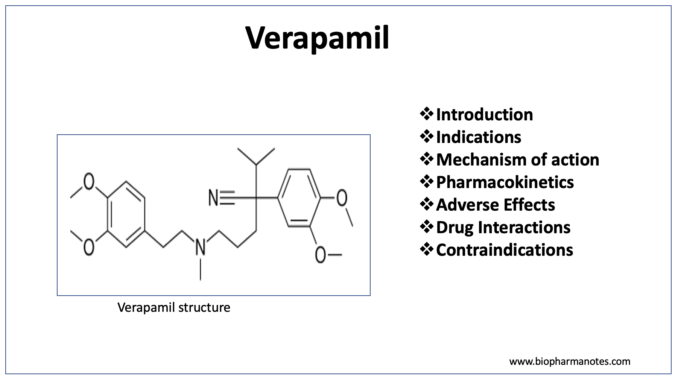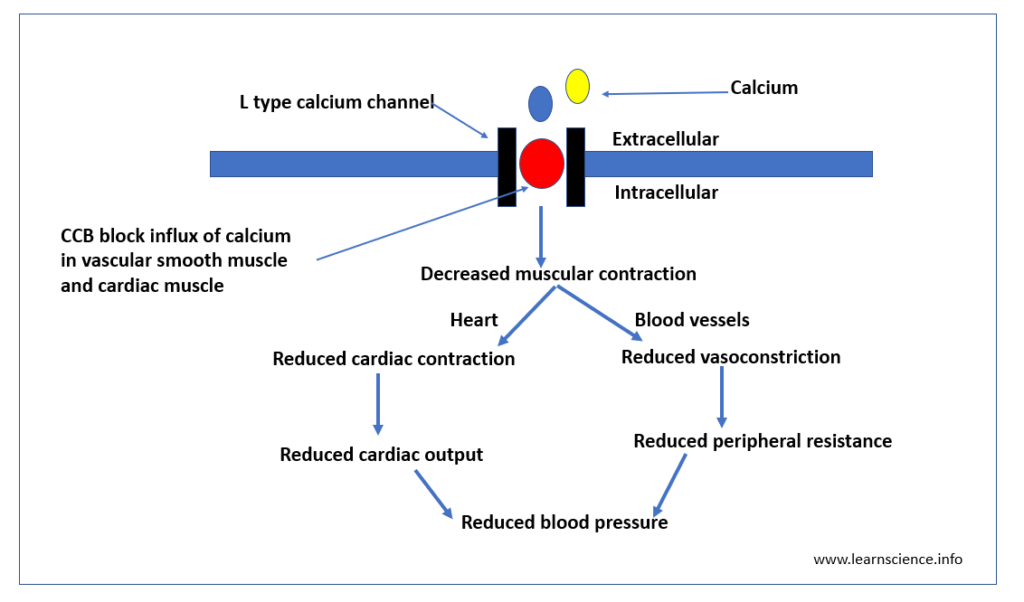
- Verapamil is non-dihydropyridine CCB (Calcium Channel Blocker) belonging to diphenyl alkylamine group. Calcium channel blocker (CCBs) also known as calcium channel antagonist or calcium antagonist are group of medicines that block movement of calcium through calcium channel.
- It was first calcium channel blocker to be introduced in medical field.
Indications of verapamil
- It is used as anti-anginal drug in various kind of angina including chronic stable, vasospastic and unstable angina.
- Used as add on therapy with other anti-hypertensive agent to treat hypertension.
- Used to treat supraventricular tachycardia (SVT) and in prophylaxis of paroxysmal supraventricular tachycardia (PSVT).
- Some of its non- FDA approved uses include acute coronary syndrome, idiopathic ventricular tachycardia, and hypertrophic cardiomyopathy.
Mechanism of action of verapamil

Figure 1- Mechanism of action of verapamil is similar to other CCBs
- Its mechanism of action is similar to other CCBs i.e. by blocking calcium channel. Calcium plays important role in excitation-contraction coupling in the skeletal, cardiac and smooth muscle. The contractility of cardiac and vascular smooth muscle is highly dependent on extracellular calcium.
- There are two types of calcium channel in heart: L channel and T channel.
- Verapamil binds to alpha-1 subunit of L channel and inhibit entry of calcium into cardiac and vascular smooth muscle. This causes decrease in intracellular calcium leading to relaxation of vascular smooth muscle, vasodilation and ultimately reduce blood pressure. This is useful in patients with hypertension. It reduces contraction in cardiac muscle and slows sinus pacemaker and AV conduction.
- It increases oxygen delivery in myocardium which is helpful un patients with vasospastic angina.
Pharmacological actions of verapamil
- It causes coronary and peripheral vasodilation.
- Verapamil causes suppression of calcium dependent SA and AV nodes.
- It possesses potent negative ionotropic effect.
- It has potent anti-arrhythmic effect.
Pharmacokinetics
- Administered via oral or IV route. It is available as both immediate and sustained release product. Usually, patients are suggested to take sustained release form with food and os swallowed whole (not crushed or chewed).
- In case of immediate release verapamil, 3-4 times dosing per day is required due to short duration of action. However, with sustained release form, once per day dosing is required.
- When administered through oral route, it is absorbed completely. However, major portion undergoes first pass metabolism and hence bioavailability ranges from 20- 30%.
- It extensively binds to protein, mainly albumin. It is extensively metabolized in liver.
- The major portion of administered drug is excreted as metabolites in urine (around 70%). Small percentage is excreted unchanged in urine and remaining is excreted via feces.
- Its half-life may increase in patients with hepatic impairment and in elderly patients. Hence, dosage adjustment is required.
Adverse effect
- Common side effects include constipation, vertigo, fatigue, hypotension and gingival hyperplasia.
- It can also cause bradycardia, heart block and CHF. There is rare chances of causing cardiac asystole.
Drug Interactions
- Like other CCBs, when it is administered together with products containing grapefruit juice, can affect heart rate and blood pressure. It can cause headache and dizziness. So, grapefruit juice should be avoided while taking verapamil.
- IV verapamil when used together with betablocker can cause circulatory collapse. So, the concurrent administration with beta-blockers should be avoided.
- Verapamil increase plasma level of digoxin and cyclosporine. It decreases excretion of drugs like midazolam, triazolam, lomitapide and ivabradine.
Contraindications
- Contraindicated in patients with hypersensitivity to verapamil.
- It is avoided in patients with heart failure, especially heart failure with reduced ejection fraction.
- It can cause first degree AV block. The chances of causing high degree AV block is more in patients with sick sinus syndrome. Hence, it is either discontinued or dosage is adjusted.
- Used with caution in patients with hypertrophic cardiomyopathy.
- Contraindicated in patients with severe hypotension, severe dysfunction of left ventricle.
- Contraindicated in patients with atrial flutter/ fibrillation with an accessory bypass tract.
References
- https://www.ncbi.nlm.nih.gov/books/NBK538495/
- https://go.drugbank.com/drugs/DB00661
- Frishman WH et al. Verapamil in Treatment of Chronic Stable Angina. Arch Intern Med.1983; 143(7): 1407-1415.
- Singh BN et al. Verapamil: A Review of its Pharmacological Properties and Therapeutic Use. Drugs. 1978; 15: 169–197.
- Pharmacology and Pharmacotherapeutics. 24th edition.
- Goodman and Gillman Manual of Pharmacology and Therapeutics.
- Lippincott Illustrated Reviews Pharmacology, 6th edition.
- A Textbook of Clinical Pharmacology and Therapeutics. 5th edition.